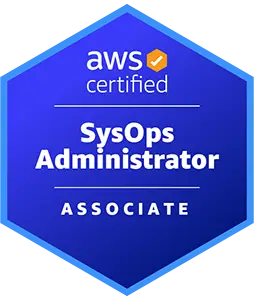
Cloud Operations on AWS
The course covers the specific AWS features and tools related to configuration and deployment, in addition to best practices for configuring and deploying systems. This course teaches systems operators and anyone performing cloud operations functions how to manage and operate automatable and repeatable deployments of networks and systems on the AWS platform.
Training at a glance
Level
Intermediate
Duration
3 Days
Experience
3 years: AWS Technical Essentials
Average Salary
$130,802
Labs
Yes
Level
Intermediate
Duration
3 Days
Experience
3 years: AWS Technical Essentials
Average Salary
$130,802
Labs
Yes
Training Details
In this course, you will learn how to:
- Identify the AWS services that support the different phases of Operational Excellence, an AWS Well-Architected Framework pillar
- Manage access to AWS resources using AWS accounts and organizations and AWS Identity and Access Management (IAM)
- Maintain an inventory of in-use AWS resources by using AWS services, such as AWS Systems Manager, AWS CloudTrail, and AWS Config
- Develop a resource deployment strategy using metadata tags, Amazon Machine Images (AMIs), and AWS Control Tower to deploy and maintain an AWS cloud environment
- Automate resource deployment by using AWS services, such as AWS CloudFormation and AWS Service Catalog
- Use AWS services to manage AWS resources through CloudOps lifecycle processes, such as deployments and patches
- Configure a highly available cloud environment that uses AWS services, such as Amazon Route 53 and Elastic Load Balancing, to route traffic for optimal latency and performance
- Configure AWS Auto Scaling and Amazon EC2 Auto Scaling to scale out your cloud environment based on demand
- Use Amazon CloudWatch and associated features, such as alarms, dashboards, and widgets, to monitor your cloud environment
- Manage permissions and track activity in your cloud environment by using AWS services, such as AWS CloudTrail and AWS Config
- Deploy your resources to an Amazon Virtual Private Cloud (Amazon VPC), establish necessary connectivity to your Amazon VPC, and protect your resources from disruptions of service
- State the purpose, benefits, and appropriate use cases for mountable storage in your AWS Cloud environment
- Explain the operational characteristics of object storage in the AWS Cloud, including Amazon Simple Storage Service (Amazon S3) and Amazon S3 Glacier
- Build a comprehensive cost model to help gather, optimize, and predict your cloud costs by using services such as AWS Cost Explorer and the AWS Cost & Usage Report
Module 1: Introduction to Cloud Operations on AWS
- What is Cloud Operations
- AWS Well-Architected Framework
- AWS Well-Architected Tool
Module 2: Access Management
- AWS Identity and Access Management (IAM)
- Resources, accounts, and AWS Organizations
Module 3: System Discovery
- Methods to interact with AWS services
- Tools for automating resource discovery
- Inventory with AWS Systems Manager and AWS Config
- Hands-On Lab: Auditing AWS Resources with AWS Systems Manager and AWS Config
Module 4: Deploy and Update Resources
- Cloud Operations in deployments
- Tagging strategies
- Deployment using Amazon Machine Images (AMIs)
- Deployment using AWS Control Tower
Module 5: Automate Resource Deployment
- Deployment using AWS CloudFormation
- Deployment using AWS Service Catalog
- Hands-On Lab: Infrastructure as Code Formation blueprints
Module 6: Manage Resources
- AWS Systems Manager
- Hands-On Lab: Operations as Code
Module 7: Configure Highly Available Systems
- Distributing traffic with Elastic Load Balancing
- Amazon Route 53
Module 8: Automate Scaling
- Scaling with AWS Auto Scaling
- Scaling with Spot Instances
- Managing licenses with AWS License Manager
Module 9: Monitor and Maintain System Health
- Monitoring and maintaining healthy workloads
- Monitoring AWS infrastructure
- Monitoring applications
- Hands-On Lab: Monitor Applications and Infrastructure
Module 10: Data Security and System Auditing
- Maintaining a strong identity and access foundation
- Implementing detection mechanisms
- Automating incident remediation
Module 11: Operate Secure and Resilient Networks
- Building a secure Amazon Virtual Private Cloud (Amazon VPC)
- Networking beyond the VPC
Module 12: Mountable Storage
- Configuring Amazon Elastic Block Store (Amazon EBS)
- Sizing Amazon EBS volumes for performance
- Using Amazon EBS snapshots
- Using Amazon Data Lifecycle Manager to manage your AWS resources
- Creating backup and data recovery plans
- Configuring shared file system storage
- Hands-On Lab: Automating with AWS Backup for Archiving and Recovery
Module 13: Object Storage
- Deploying Amazon Simple Storage Service (Amazon S3)
- Managing storage lifecycles on Amazon S3
Module 14: Cost Reporting, Alerts, and Optimization
- Gaining AWS cost awareness
- Using control mechanisms for cost management
- Optimizing your AWS spend and usage
- Hands-On Lab: Capstone lab for CloudOps
This course is intended for:
- System administrators and operators who are operating in the AWS Cloud
- Informational technology workers who want to increase their system operations knowledge
We recommend that attendees of this course have the following prerequisites:
- Successfully completed the AWS Technical Essentials course
- Background in either software development or systems administration
- Proficiency in maintaining operating systems at the command line, such as shell scripting in Linux environments or cmd/PowerShell in Windows
- Basic knowledge of networking protocols (TCP/IP, HTTP)
Upcoming Classes
We Offer More Than Just AWS Training
Our successful training results keep our corporate and military clients returning. That’s because we provide everything you need to succeed. This is true for all of our courses.
Strategic Planning & Project Management
From Lean Six Sigma to Project Management Institute Project Management Professional, Agile and SCRUM, we offer the best-in-class strategic planning and project management training available. Work closely with our seasoned multi-decade project managers.
IT & Cybersecurity
ATA is the leading OffSec and Hack the Box US training provider, and a CompTIA and EC-Council award-winning training partner. We offer the best offensive and defensive cyber training to keep your team ahead of the technology skills curve.
Leadership & Management
Let us teach your team the high-level traits and micro-level tools & strategies of effective 21st-century leadership. Empower your team to play to each others’ strengths, inspire others and build a culture that values communication, authenticity, and community.
